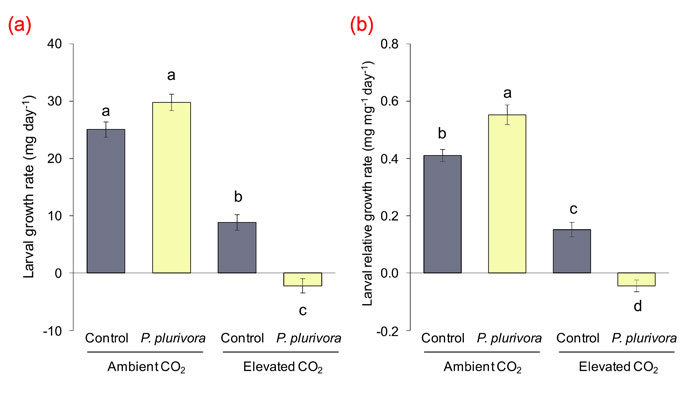| Tweet | Follow @co2science |
Paper Reviewed
Milanovic, S., Milenkovic, I., Dobrosavljevic, J., Popovic, M., Solla, A., Tomsovsky, M. and Jankovsky, L. 2020. Growth rates of Lymantria dispar larvae and Quercus robur seedlings at elevated CO2 concentration and Phytophthora plurivora infection. Forests 11: 1059, doi:10.3390/f11101059.
Writing by way of introduction, Milanovic et al. (2020) say that interactions between plants, pests and pathogens "are complex and poorly understood in the context of climate change." In particular, they note "very little is known about how elevated CO2 affects pests and pathogens inhabiting the same host." And so, given such paucity of data, the seven European scientists set out to explore such interactions between European oak (Quercus robur) trees, gypsy moth larvae (Lymantria dispar) and the root pathogen Phytophthora plurivora.
The work was conducted under controlled-environment conditions where 1-year-old oak seedlings were subjected to one of two atmospheric CO2 treatments: ambient (~400 ppm) or elevated (~1,000 ppm). Thirty days later, a subset of trees in each CO2 treatment were inoculated with the root pathogen P. plurivora, and two weeks after that half of all trees in each of the preceding treatments were infested with gypsy moth larvae. One month after the introduction of the gypsy moth larva Milanovic et al. examined the impacts of CO2 on the interrelationships between pest, pathogen and host.
And what did that analysis reveal?
During the 2.5 months of CO2 enrichment, elevated CO2 exerted a positive influence on oak seedling growth, boosting the average number of leaves by 55% and raising the mean seedling height by 46%. What is more, Milanovic et al. report oak tree growth rates "were 150.3% higher in seedlings exposed to elevated CO2 than in seedlings exposed to ambient CO2." And the good news does not stop here. With respect to gypsy moth larval growth, the authors report this parameter was similar regardless of root pathogen infection by P. plurivora under ambient CO2 conditions (see Figure 1a). However, under elevated CO2 larval growth rate was significantly reduced. As reported by the authors, on average, "larvae consuming leaves from Q. robur plants exposed to ambient CO2 concentration gained 27.5 mg per day, while larvae consuming leaves from plants exposed to elevated CO2 concentration gained 3.6 mg per day." Similar reductions were noted for larval relative growth rates, which averaged 0.49 and 0,06 mg mg-1 day-1 in the ambient and elevated CO2 treatments (see Figure 1b).
Clearly, given the above, elevated CO2 exerted, in the words of the authors, "a negative effect on gypsy moth larval performance and a positive effect on [oak] growth." And that is great news for European oak forests that are presently under siege by this damaging pest.

Figure 1. Mean growth rates (a) and mean relative growth rates (b) of gypsy moth (Lymantria dispar) larvae reared on European oak seedlings that were subjected to infection or non-infection (control) of the root pathogen Phytophthora plurivora under ambient or elevated CO2 concentrations. Vertical bars are standard errors and different letters indicate significant differences (p < 0.01) of mean values (n = 12) according to the Tukey HSD test. Source: Milanovic et al. (2020).




